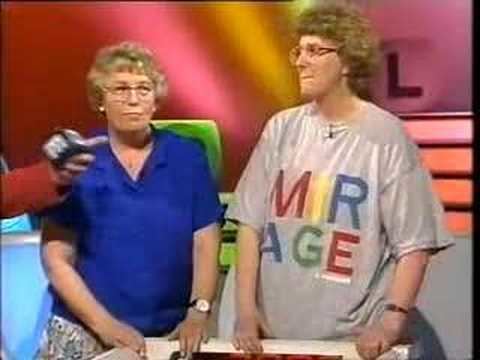Narrated by Randy West No. of seasons 1 Original network The Family Channel Final episode date 18 November 1994 Number of seasons 1 Genre Game show | Country of origin United States Running time 30 minutes First episode date 7 March 1994 Presented by Wink Martindale Program creator Wink Martindale | |
 | ||
Created by Wink Martindale
Bill Hillier Similar Game show, Tic‑Tac‑Dough, Tien voor taal, Bumper Stumpers, Headline Chasers | ||
Boggle game show 1994 wink martindale contestant terry ray
Boggle is an American game show that was broadcast on The Family Channel from March 7 to November 18, 1994. It was based on the board game of the same name. Wink Martindale was the host, and Randy West was the announcer.
Contents
- Boggle game show 1994 wink martindale contestant terry ray
- Boggle pilot
- Round 1
- Round 2
- Round 3
- Interactive Component
- References
Wink Martindale and Bill Hillier created and produced four "interactive" games for FAM, Boggle being one of them. The other three were Trivial Pursuit, Shuffle, and Jumble. Wink hosted all four. Randy West was the announcer for all four of these shows as well.
Boggle had its premiere on the same day as Shuffle. The two shows shared the same theme song and sound effects - the two even used the same set; after taping on Boggle was finished, the set pieces were redone and rearranged to make Shuffle's set. The set pieces would be re-done a third time for Jumble.
A pilot episode for Boggle was filmed in 1987 and was hosted by Bill Rafferty, but it did not sell. The pilot episode was conducted under different rules.
Boggle pilot
Round 1
Four players competed. Each one has a 3x4 telephone keypad built into their podium, which they would use to find words in a Boggle board. A typical Boggle board is illustrated to the right.
The words would be formed from adjacent letters, and cannot use the same letter more than once. Wink made sure to tell the contestants to ignore the letters on their telephone keypad and only focus on the ones on the board. Using the example board, a contestant could press 6, 8, 9, and # to spell S-O-C-K.
Wink would read a clue to a word, and contestants would have 10 seconds to punch in the keys corresponding to the word. After three seconds, the first letter of the word would be revealed. Contestants would get points depending on how quickly they punched in the right answer, starting at 1,000 and counting down as time went on.
Five words were played; the first three were four letters long, and the last two were five letters long. After those five words, the player with the lowest score was eliminated.
Round 2
In Round 2, all the scores were reset to zero and the three remaining contestants would play a new Boggle board. The lowest scoring player after five more words was eliminated.
Round 3
In Round 3, the scores were reset to zero again and one final Boggle board was played. The contestant with the highest score after five more words won a trip (and a smaller prize to go with it). The second-place player won a smaller prize.
Interactive Component
After each round with the studio players concluded, home viewers could call a special 1-900 number and play a game of "Interactive Boggle". The cost to play was $4.98. It was played just like a round of the studio game, and home viewers answered by using their touch-tone telephone. The home viewer with the highest score would receive a small prize and the right to enter a weekly playoff. The playoff would be played exactly as before, and the ultimate winner would receive a trip.
